#The Nike of Samothrace statue
Explore tagged Tumblr posts
Text
I've been sick and really out of it, and felt possessed to print out some classic statues. I asked my partner for one to start with, and they chose Winged Victory of Samothrace
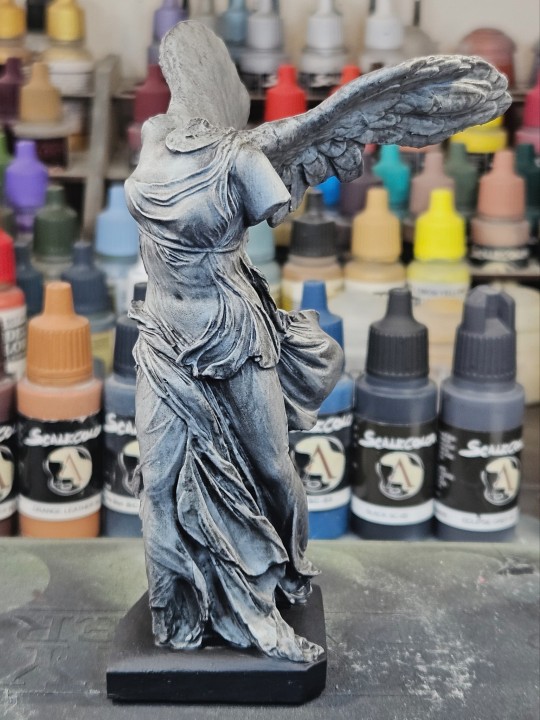

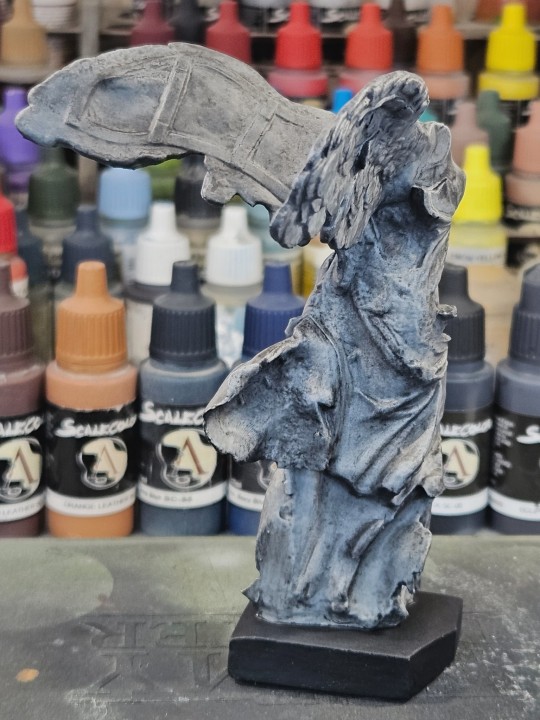
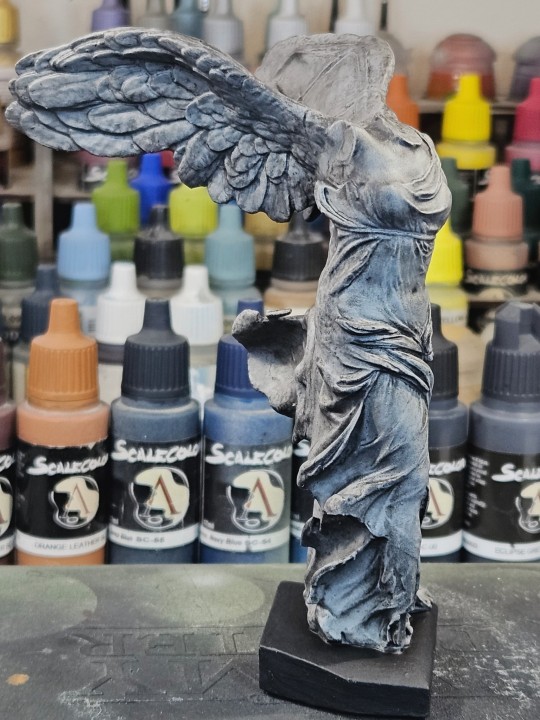
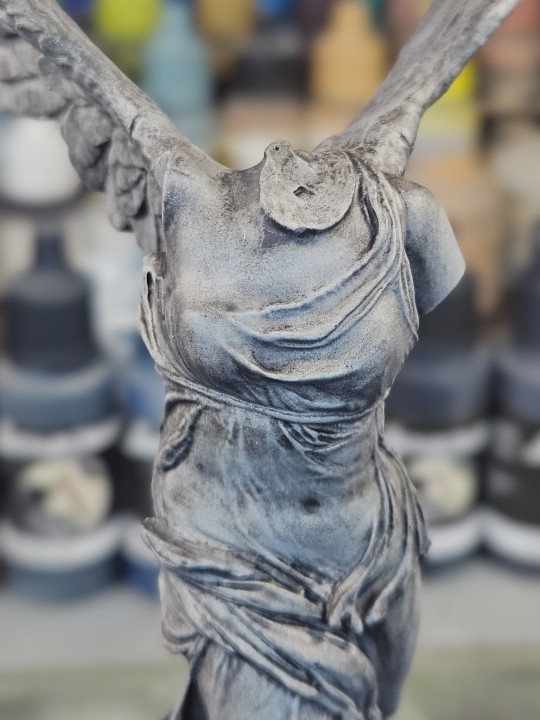
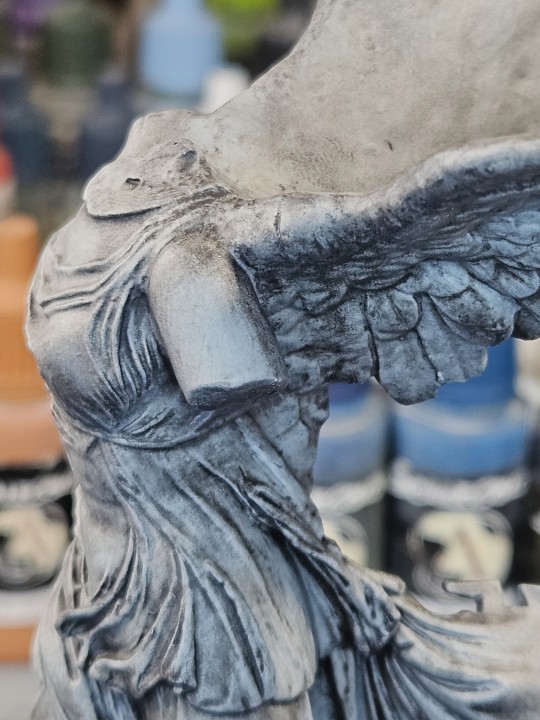
I love that museums and independent organizations just go around using high quality scanners to help make history more accessible, even in small ways like this. I'll likely never visit the Louvre, or Greece if they ever get it back, but I can print my own
#art#painting#canopiancatboyart#miniature#miniatures#3d printing#miniature painting#oil painting#statue#statuary#classical art#ancient history#greece#greek mythology#nike#winged victory of samothrace#hellenistic#monument
327 notes
·
View notes
Text

My favorite statue for a reason
#i really hate how these wings look#traditional art#art#greek mythology#my art#nike of samothrace#nike#tagamemnon#mythology#ancient greece#artist#statue
22 notes
·
View notes
Text
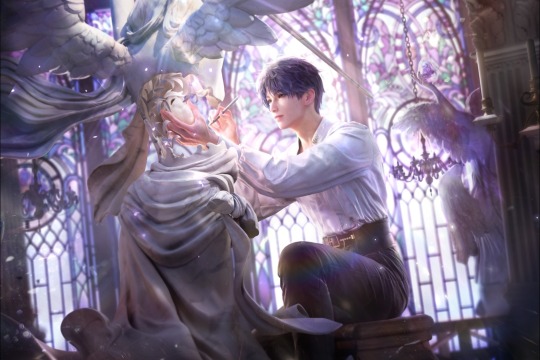

Why does the sculpture Rafayel's "restoring" in Ivory Nightfall looks like The Nike of Samothrace statue/Winged Victory sculpture? Yes, I'm obsessed with it and hope to see it in person one day. No, it's not because I found out that my name is the Spanish form of Victoria.
(Which brings up kind of a funny stor(ies) depending on how you look at it. Whenever they ask me for my name at drive-thru intercoms, they mishear my name as Victoria. Since allegedly my name is a different form of Victoria, I just roll with it🤷🏾♀️. I even remember as a kid some folks called me Tori instead of Toya🤔)
#i love ivory nightfall#its one of my favorite Rafayel tender moments#love and deepspace#rafayel#love and deepspace rafayel#art#lads rafayel#lnds rafayel#The Nike of Samothrace statue#the winged victory
25 notes
·
View notes
Text

Νίκη της Σαμοθράκης
Nike of Samothrace
Η Νίκη της Σαμοθράκης είναι μαρμάρινο γλυπτό άγνωστου καλλιτέχνη της ελληνιστικής εποχής που βρέθηκε στο ναό των «Μεγάλων Θεών» Καβείρων στη Σαμοθράκη, παριστάνει φτερωτή τη θεά Νίκη και εκτίθεται στο Μουσείο του Λούβρου από το 1884.
Είναι μία από τις τρεις φτερωτές Νίκες που βρέθηκαν στο ναό της Σαμοθράκης.
Οι άλλες δύο εκτίθενται η μεν πρώτη, που αποτελεί ρωμαϊκό αντίγραφο και το βρήκαν Αυστριακοί αρχαιολόγοι, στο μουσείο “Kunsthistorisches Museum” της Βιέννης και η δεύτερη, που βρέθηκε από την αμερικανική αποστολή του Karl Lehmann και της Phyllis Williams-Lehmann το 1949, στο αρχαιολογικό μουσείο της Σαμοθράκης.
Ο Lehmann και η σύζυγός του βρήκαν αργότερα (το 1950) σε ανασκαφές και τμήματα του δεξιού χεριού της «Νίκης της Σαμοθράκης». Λίγους μήνες μετά το ίδιο ζευγάρι αρχαιολόγων εντόπισε και δάχτυλα του δεξιού χεριού της ίδιας Νίκης στο προαναφερόμενο αυστριακό μουσείο, που τα είχε ακαταχώρητα και δεν γνώριζε ότι ανήκαν σε εκείνην.
Η δεξιά παλάμη της ανασυστάθηκε αποκαλύπτοντας ότι δεν κρατούσε σάλπιγγα όπως πολλοί πίστευαν μέχρι τότε και εκτίθεται επίσης στο Λούβρο, σε χωριστή βιτρίνα κοντά στα άγαλμα.
Το άγαλμα έχει ύψος 3,28 μ (με τα φτερά) και 5,58 με την πλώρη του πλοίου πάνω στην οποία είναι τοποθετημένο σήμερα. Φιλοτεχνήθηκε σε λευκό Παριανό μάρμαρο για να τιμήσει τη θεά Νίκη αλλά και μια ναυμαχία – δεν είναι βέβαιο ποια. Ήταν αφιερωμένο σε ναό της Σαμοθράκης και χρονολογείται μεταξύ και 220 και 190 π.Χ. – οι περισσότεροι συγκλίνουν στο 190 π.Χ.
Σήμερα στο Μουσείο του Λούβρου το έχουν τοποθετήσει σε μια βάση και αυτή με τη σειρά της είναι στερεωμένη σε μαρμάρινη πλώρη πλοίου. Στην αρχαιότητα εικάζεται ότι εκείνος που αφιέρωσε το έργο στο ναό της Σαμοθράκης (τόπο φημισμένο στην αρχαιότητα για την ιερότητά του) είχε δώσει παραγγελία να σχεδιαστεί ένα μικρό σύμπλεγμα θεάς και πλοίου.
Η μεν θεά φιλοτεχνήθηκε χωριστά από λευκό παριανό μάρμαρο και ίσως κρατούσε στεφάνι για το νικητή ή είχε υψωμένο το χέρι της στο στόμα για να διαλαλήσει τη νίκη χωρίς να κρατά τίποτα ή, τέλος, ίσως χαιρετούσε. Το άγαλμα στο ελληνιστικό σύμπλεγμα ήταν στερεωμένο στην επίσης μαρμάρινη πλώρη ενός πλοίου και έδινε την αίσθηση ότι μόλις είχε «προσγειωθεί» σε αυτό και πατούσε φευγαλέα. Το πλοίο ήταν από μάρμαρου Ρόδου. Οι ειδικοί εικάζουν ότι το έργο ήταν σχεδιασμένο για να το βλέπει ο κόσμος από τα αριστερά, κατά τα ¾ του προφίλ, επειδή όπως συνηθιζόταν στα ελληνιστικά χρόνια ήταν πιο καλοδουλεμένη η μία πλευρά του –εκείνη από την οποία προοριζόταν να το βλέπει το κοινό.
Μία εκδοχή των αρχαιολόγων για το αφιέρωμα επί πολλά χρόνια ήταν πως το είχε κάνει ο Δημήτριος ο Πολιορκητής (337-283 π.Χ.) όταν νίκησε τον στόλο του Πτολεμαίου στα ανοιχτά της Κύπρου γύρω στο 290 π.Χ.
Σήμερα όμως πολλοί πιστεύουν ότι το αφιέρωσαν οι Ρόδιοι όταν το 191 π.Χ., συμμαχώντας με την Πέργαμο, νίκησαν τον Αντίοχο Γ΄ της Συρίας σε ναυμαχία στα ανοιχτά της Σίδης
Το δεξιό φτερό βρέθηκε σχεδόν διαλυμένο εκτός από μικρά κομμάτια του και αποτελεί πρόσθετο έργο ανασύστασης «καθρέφτη» του αριστερού, από εμπειρογνώμονες του Λούβρου. Το άγαλμα εικάζεται ότι κατακρημνίστηκε και έσπασε εξαιτίας μεγάλου σεισμού κατά τον 6ο μ.Χ. αιώνα.
Τα κομμάτια του γλυπτού βρέθηκαν τμηματικά και στην αρχή η Νίκη εκτίθετο στο Λούβρο δίχως τον κορμό και τα φτερά της αλλά και δίχως την πλώρη, τα κομμάτια της οποίας οι Γάλλοι ειδικοί στην αρχή είχαν εκλάβει ότι ανήκαν σε τύμβο και τα είχαν αφήσει στη Σαμοθράκη.
Συγκεκριμένα, η ανεύρεση άρχισε το 1863 από μια αρχαιολογική αποστολή στην οποία επικεφαλής ήταν ο Κάρολος Σαμπουαζό (1830-1909) (Charles Champoiseau) υποπρόξενος της Γαλλίας στην Αδριανούπολη (σημερινό Εντιρνέ Τουρκίας). Ενώ έσκαβαν σε μια χαράδρα στις 15 Απριλίου του 1863, στα βόρεια του νησιού, ένας Έλληνας εργάτης φώναξε στον Σαμπουαζό «Κύριε, εύραμεν μια γυναίκα!» – ήταν η μισή Νίκη της Σαμοθράκης.
Ο Σαμπουαζό ήρθε αμέσως σε επικοινώνια με τον πρέσβη της πατρίδας του στην Κωνσταντινούπολη και εκείνος φρόντισε η Τουρκία να δώσει τότε έγκριση για να αποπλεύσει γαλλικό πολεμικό πλοίο και να φορτώσει τη Νίκη της Σαμοθράκης για τη Γαλλία -η Σαμοθράκη είχε σημαντική αυτονομία, αλλά ανήκε ακόμα στην Οθωμανική Αυτοκρατορία και απελευθερώθηκε στις 19 Οκτωβρίου του 1912 Το άγαλμα έφτασε στο Λούβρο στις 11 Μαϊου του 1864 και δύο χρόνια μετά εκτέθηκε για πρώτη φορά μετά τις απαραίτητες εργασίες – χωρίς όμως ακόμα να μπορούν να εκθέσουν το επάνω μέρος τους κορμού και τα φτερά.
Το άγαλμα βρέθηκε σε πολλά κομμάτια γιατί στα ελληνιστικά χρόνια οι καλλιτέχνες δούλευαν το γλυπτό τους σε πολλά κομμάτια εξαρχής – στην αρχαία Ελλάδα δούλευαν χωριστά μόνον το κεφάλι και τα άκρα που εξείχαν. Ο άγνωστος λοιπόν γλύπτης είχε επεξεργαστεί το έργο του κατά ��μήματα και μετά το είχε ενώσει, οπότε στο σεισμό με την κατακρήμνιση του γλυπτού, αυτό έσπασε πολύ πιο εύκολα και σε πολλά σημεία.
Αποτελείται από το μεγάλο κομμάτι κάτω από το στήθος μέχρι τα πόδια, από ένα δεύτερο κομμάτι που είναι ο άνω κορμός, το αριστερό φτερό (το δεξί προστέθηκε αντιγράφοντας το αριστερό) και από το κεφάλι – αυτό δεν βρέθηκε ποτέ από όσο γνωρίζουν οι ειδικοί. Τα χέρια, τα φτερά και τα πόδια, όπως και πολλά κομμάτια του ενδύματος σμιλεύονταν τότε χωριστά και μετά το άγαλμα συναρμολογείτο. Τα φτερά ήταν από δύο μεγάλα μάρμαρα που ήταν συνδεδεμένα στην πλάτη χωρίς εξωτερική στήριξη και αυτό δημιουργούσε πρόβλημα ισορροπίας στο άγαλμα, αλλά ο γλύπτης το έλυσε με μεγάλη τέχνη
Το 1875 Αυστριακοί αρχαιολόγοι είδαν στον τόπο της ανασκαφής τα μάρμαρα που ο Σαμπουαζό νόμισε ότι ανήκαν σε τύμβο και αναλογιζόμενοι ελληνικά νομίσματα που απεικόνιζαν τη Νίκη σε πλώρες πλοίων κατάλαβαν ότι επρόκειτο για τμήματα μαρμάρινης πλώρης. Ο Σαμπουαζό έμαθε για τα μάρμαρα της πλώρης το 1879 και κατάφερε να τα πάρει κι αυτά στ�� Λούβρο. Η συναρμολόγηση και η αποκατάσταση (π.χ. του αριστερού φτερού που βρέθηκε σε πολλά κομμάτια και του δεξιού που ουσιαστικά είναι σχεδόν όλο προσθήκη μια που βρέθηκε ένα πολύ μικρό κομμάτι του) ολοκληρώθηκε το 1884
πηγη: Wikipedia
#Νίκη της Σαμοθράκης#άγαλαμ#ιστορία#έργο τέχνης#Λούβρο#Αρχαία Ελλάδα#Ελλάδα#Nike of Samothrace#Winged Victory#statue#Ancient Greece#Greek#art
12 notes
·
View notes
Text

"Nike of Samothrace"
I love this statue. I found it really fun to draw out of white charcoal.
6 notes
·
View notes
Text
i will never beat the accidental poetry of comparing the winged victory of samothrace (the nike statue) and the lament of icurus in my comparative study and being able to say the main difference is one is about victory and the other is about failure
#the winged victory of samothrace#statue of nike#winged victory of nike#winged victory of samothrace#the lament for icarus#the lament of icarus#ib art#art history#comparative study#ib art comparative study
4 notes
·
View notes
Text

frank lloyd wrights “martin house”
#mine#pinterest#frank lloyd wright#architecture#victory of samothrace#winged victory#statue of nike#nike#greek statues#buffalo ny#FLW#interiors#greenhouse#conservatory
3 notes
·
View notes
Text
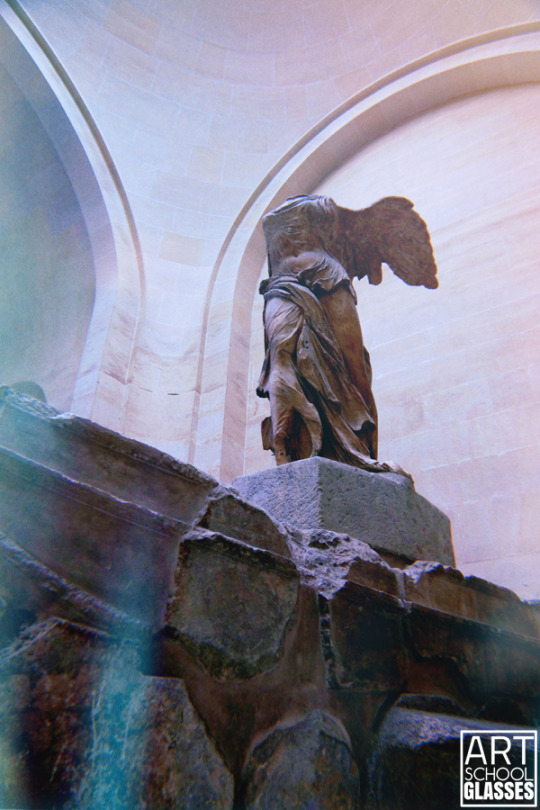
Winged Victory in the Louvre
Paris, France
#winged victory#nike of samothrace#nike#louvre#paris#france#europe#travel#travelling#museum#gallery#art#art history#sculpture#statue#my photos
47 notes
·
View notes
Text
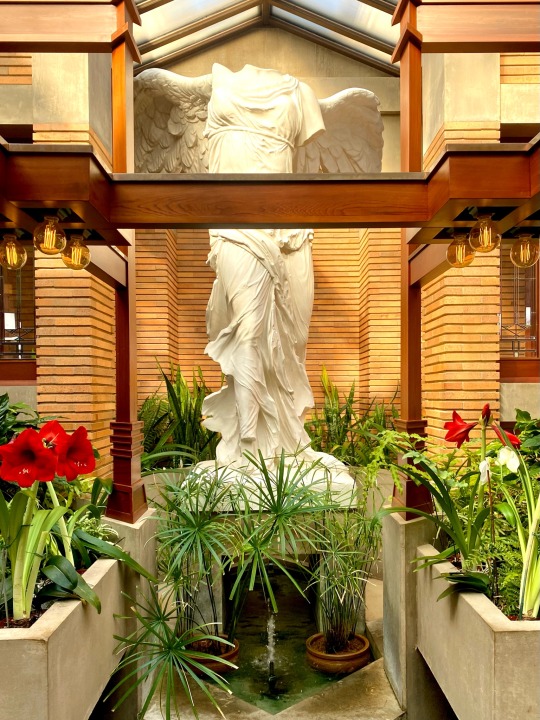
frank lloyd wright’s martin house, 1/4/24
#frank lloyd wright#darwin martin#buffalo#architecture#nike of samothrace#statues#dark academia#light academia#academia aesthetic#museum#angelcore#greenhouse#amaryllis
8 notes
·
View notes
Text
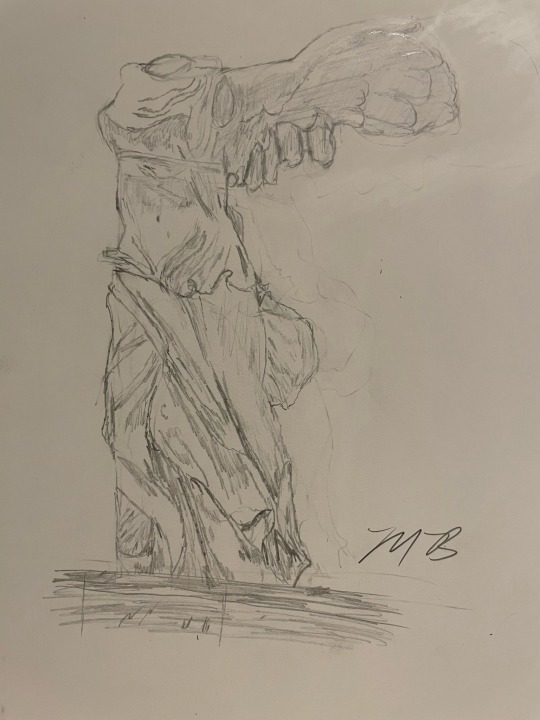
Winged Victory of Samothrace, from the Louvre
0 notes
Text
loving jason todd is like caring for an old marble statue.
he looks like something straight out of greek mythology, something pygmalion would have crafted with rough hands and bright eyes for nights on end. scars from battle like ares, or maybe he's closer to hephaestus considering his past.
but time hasn't treated him well, he's been broken and put back together more times than he can count. there are bad days where he can barely feel the parts of him that had once been taken away only to be stitched back on, where he feels like he's missing arms or ribs or even his head, and he feels as if he'd be right at home between nike of samothrace and venus of milo.
those days, he forces himself through the dark, grimy streets, body on autopilot as he watches limbs that aren't his own fight and bruise and bleed.
but then he comes home to you and slowly, slowly he feels whole again.
your fingers gently tap his before tugging at them, digits intertwined as you raise his hand up to your lips. you're just so warm and suddenly he feels his hand again, that fuzzy feeling gently running up his arm like spring water. he's thinking that the way your fingers are laced together reminds him of the crochet pattern he'd been trying to learn last night when before he realizes it, his other hand is moving on its own, finding purchase on your cheek.
it can't be a pleasant feeling, he thinks. he knows for a fact his hands are rough and calloused, years of abuse caked onto them in the form of scratchy white spots and ugly scars. but before he can take it away, you lean into it, nuzzling his palm as if it brings you comfort.
he brings you comfort, he realizes.
he stands there for a while, both hands now cupping your face, careful not to hold on too tight. his thumbs brush over the apples of your cheeks, feather light on each eyelid, one even traces the slope of your nose. you're so soft, flesh easily giving way under his touch and he can't help but feel like an elephant who's been given a kitten to hold.
then finally, he arrives at your lips.
he traces your bottom lip first, one slow, gentle swipe, before giving some love to the top. without much thought, he places both his thumbs over your lips like he's seen people do for stage directions, feeling the little squish when he puts just the slightest bit of pressure. your eyes open narrowly and he finally cracks a smile at the sight of you all smushed.
you open your eyes wider and his smile softens, his gaze locking onto yours. he feels like he could drown in them, drown in you, and he'd die happy this time.
he doesn't realize either of you are moving until his eyes physically can't look at yours anymore due to the sheer distance and the angle, instead slipping closed as his lips meld onto yours. he can feel the warmth in his cheeks and each kiss feels like pure bliss, the contact grounds him so that he feels like his head's on straight again. he's sure you can hear his heartbeat - after all, it's practically thundering against his eardrums - and the rhythm it knocks into his ribcage feels so real that the bones there can't possibly be missing.
jason feels every part of his body. in a good way. everything the world had ripped away from him now returned and fixed back in place by your warm, loving hands. yes, he may be a little weathered. yes, he may never feel brand new again. but really, does any of that matter when you look at him as if he's a masterpiece?
#jason todd x reader#jason todd drabble#jason todd#jason todd x you#jason todd x y/n#red hood#red hood x reader#red hood x you#red hood drabble#red hood x y/n#jason todd comfort#jason todd fluff
1K notes
·
View notes
Text
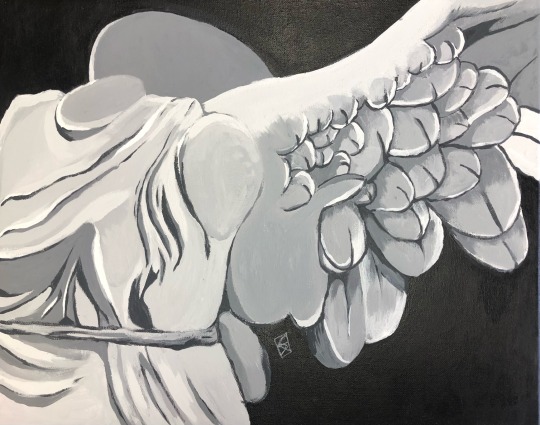
1 note
·
View note
Text


nike of samothrace // nike of paionios
the other day i went to paint a statue with some friends & it went poorly for me & now i am determined to get the hang of painting statues to make up for that experience
1K notes
·
View notes
Text
the fondest memory i have of getting to be at my Most annoying and pedantic was back when i was hanging out at a forum, and some guy was like, loudly complaining about overhearing a group of teen girls at a grocery store say harrison ford was the best actor ever. he was deeply incensed that these girls were not even CONSIDERING other historically acclaimed and objectjvely better actors before making their absolutely definitive statement.
on one hand it's already funny enough that we had to explain the concept of a hyperbole to who i remember to be a middle aged man, and maybe it was just a way of letting him concede with grace (he really did act like he had never before heard of the concept of teens making exaggerated statements without meaning it literally. like i'm autistic too but i struggle to believe that).
unfortunately because of who i am as a person, and because it was in my art history student era, i was like, sure, i'll play along. what are the objective criteria for Best Actor Ever. by what measure do we make this claim. how do we define an actor, how do we define excelling at the skills of an actor. how do we ensure that we account for bias towards gender and race? are the insitutions awarding actors for good performances objective? does such a thing as as The Best Actor Ever even exist? how do you know your favourite actors are objectively better and it's not just the perception from what your generation prefer in terms of media? people across time and place have vastly different ideas of what art is good and beautiful - did you know that many roman marble statues were painted in their day, and today we in western cultures would find the colors garish and much worse than the pure marble white? or how we love the sculpture nike of samothrace, but objectively that is a broken sculpture missing its head and arms, and it's very likely that the ancient greeks would not find her as pleasing as we do today, but because of the culture of art we have today we find elegance in the way it is broken? and -
i think the guy made a fair attempt at engaging with the discussion before he gave up. i will give him that
#i think i was like 20 at the time#i had so young and bushy tailed and lots of energy to deal with stuff like this#but now a thousand stupid twitter discourses later i can't even imagine entertaining the thought of engaging with that#this guy did list a bunch of actor who were all like. white men actors from a generation or two ago i don't recognize at all#also very practical joke of me to have this discussion when i don't even recognize good or bad acting very well#like it has to be the room levels of Bad for me to be like hm i think this acting is maybe not good?#autism trait i have. if i see a real person acting somw way i parse it as like. a way a real person would act
68 notes
·
View notes
Text
📍Island Samothrace, Greece 🇬🇷
Nike of Samothrace! Why she is in Louvre, Paris France?
In 1863, Charles Champoiseau (1830-1909), acting in charge of the Consulate of France in Adrianopolis, undertook from March 6 to May 7 the exploration of the ruins of the sanctuary of the Great Gods on the island of Samothrace. On April 13, 1863, he discovered part of the bust and the body of a large female statue in white marble accompanied by numerous fragments of drapery and feathers. He recognised this as the goddess Niké. He decided to send the statue and fragments to the Louvre Museum, and to leave the large blocks of grey marble on site. Departing Samothrace at the beginning of May 1863, the statue arrived in Toulon at the end of August and in Paris on May 11, 1864
This is one of the stories that shows how the great heritage of countries that were occupied or ruled by large empires was lost. The British Museum, the Louvre and other cultural centers of Western Europe continue to hold many great works of art. They were taken out when chaos was happening in their homeland.
Fortunately, many countries are launching processes for the repatriation of the great heritage of humanity. One example was the return of the Parthenon marbles from the Vatican Ⅲ.
The island of Samothrace continues to live in anticipation that perhaps one day Nike of Samothrace will return home.
Island Samothrace, Greece S. Scenic island with beautiful history!
@simon__kranz
#travel #travelingare #dronevideography #arcitecture #samothrace #greece #kalimeraellada
#lifestyle#myuploads#aesthetic#travel#travelingare#photography#architecture#drone photography#greece#kalimera ellada#nike of samothrace#samothraki island#an
31 notes
·
View notes
Text
The Temple of Mythal and Greek Sculpture
Or: How Bioware takes from history without any nuance.
--
Picture this. You're me, playing Inquisition for the first time. You get to the Temple of Mythal, the doors shut behind you and you finally get to look around. It's a typical elven ruin for the game, nothing much seems different...
Hold on.
Hold the fuck on.
You know what that is.
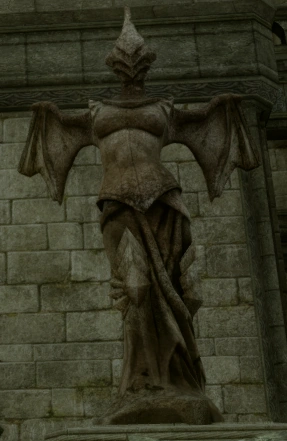
You know what that's based on, and for a long time after it tickles you. Oh, maybe that meant something in the grander scheme of things! We've never seen such a blatant reference to a real-life sculpture anywhere else in game (to my knowledge at the time)! Maybe it'll come up later and it'll all make sense!
Here's the deal. I've been bothered by this for years. The more I think about it, the more angry I become. Anger over a single fucking type of statue, you say? There's a lot of other shit to be angry over in this game, and you choose this?
YES! I CHOOSE THIS! AND THIS IS WHY.
--
Picture this. You're me again, aged 14 this time. You're in the Louvre, the first museum of Western classical art you've ever been to. You've grown up in a place where this interest could only be cultivated from extra-curricular reading, and for a kid that age from my country to be ass deep in Greek and Egyptian myth is frankly lmao. Neurodivergent. Anyway.
So we're wandering around the Louvre, I've just taken my parents through the Egyptian section and given them a thorough infodump on everything I know about burial rites.
And then we enter this room. And I very nearly fall to my knees when I catch sight of her.
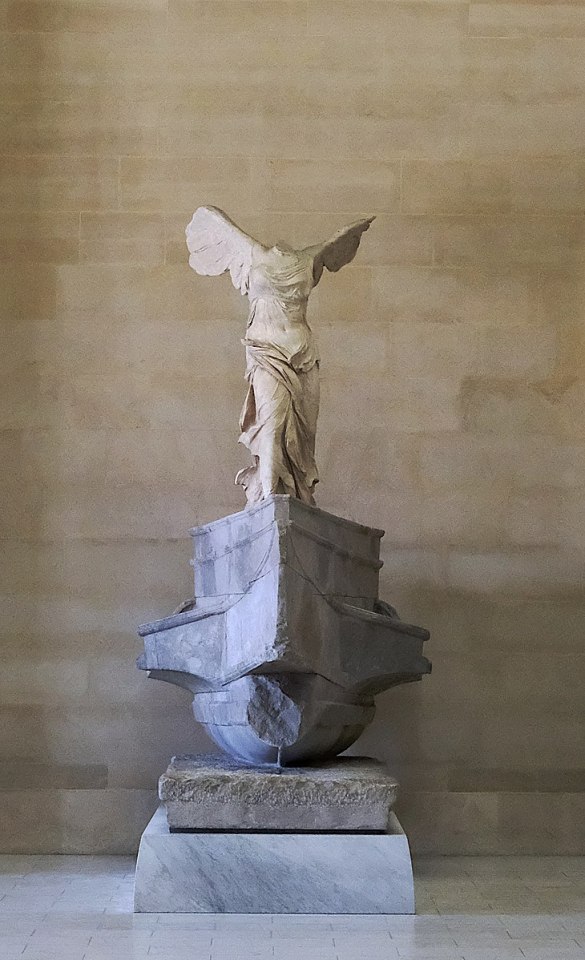
This is the sculpture the statues at the Temple of Mythal are based on - one Winged Victory of Samothrace.
She is a sculpture from the Hellenestic era, depicting the goddess Nike stood at the prow of a ship. Her head and both arms are missing, save one hand with two fingers (also in the Louvre but displayed separately). She was found on the Greek island of Samothrace, among the ruins of what was known as the Sanctuary of the Great Gods. It seemed like she was displayed at the top of a hill, looming down at all that regarded her.
I’ve had the absolute privilege of seeing her in person twice in my life, both before and after the 2013 restoration. And let me tell you, regardless of which staircase that leads you there, the sight of her will stop you in your tracks.
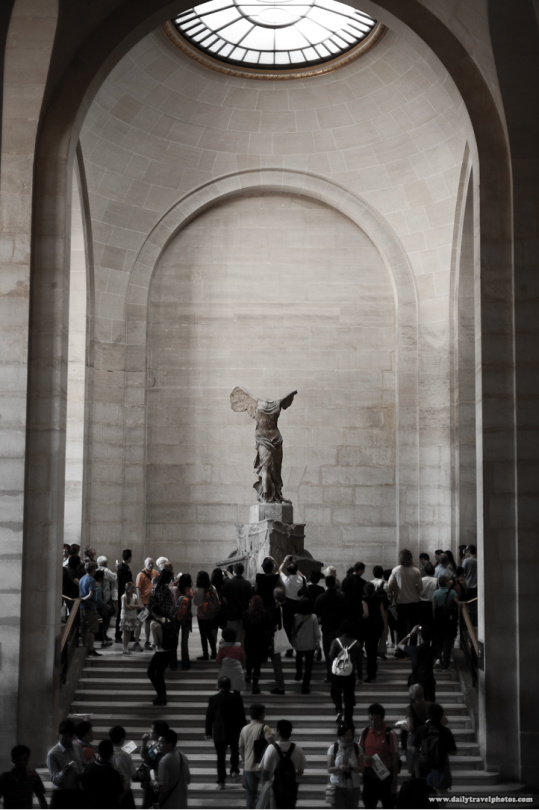
[Now with people, for scale.]
She is massive. Larger than life, and immediately is the centre of your attention. It's not the fact that she has no head, no arms. No, you will realise the closer you get to her, the more you're able to appreciate the details of this absolutely astounding piece of history.
No. It's because she feels so alive.
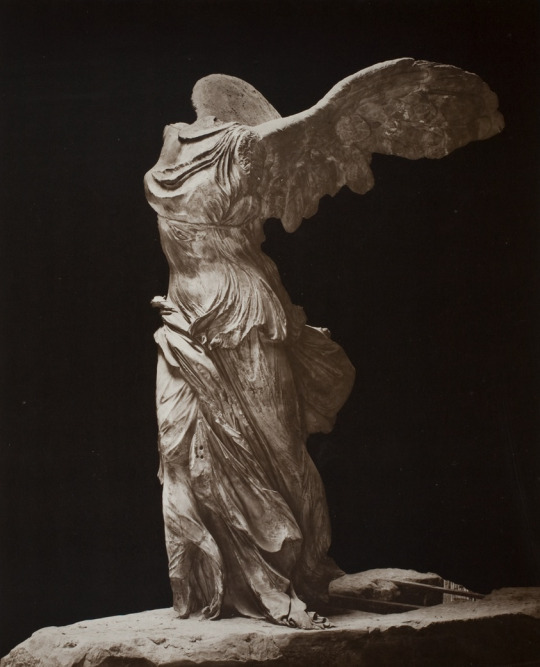
The way her robes drape against flesh, wet from sea-spray or rain, yet flowing with the motion of an invisible wind. The wings cast behind her dramatically as her right foot steps forward. Standing tall and proud, unflinching, unbowed against the elements. Even without her arms, you can feel how dynamic the torso and legs are.
You don't need to be an art historian, or even have any knowledge of Greek myth or art history to stand in front of her, as I once did as a young teen, and nearly be brought to tears.
So.
This brings me to the first of the two main gripes I have with the way this sculpture is used in Inquisition.
Compared to the way she's displayed in the Louvre, and also presumably how she was presented to her original audience - larger than life, looming, powerful, beautiful - she is relegated instead to smaller, repeating statues of the same nature throughout the temple.
This diminishes the purpose of the original sculpture, which was to instill a sense of awe and wonder. The singularity that forces you to focus and appreciate the scale and intricacy. The aura, the gravitas of having a single, massive sculpture of such a dynamic figure is completely gone.
And to make things worse, they Mythal-ify her. Adding a helmed head and changing her beautiful feathered wings to leathery dragon wings. They don't even add arms, which is odd because the original sculpture very clearly is missing its arms.
And, may I ask, Why?
It feels cheap, like they saw the Winged Victory and were like 'oh shit this is a cool sculpture, we should add it in game' without giving any fucking thought to what the sculpture means.
Which brings me to the second gripe. The complete disregard for the symbolism of the Winged Victory.
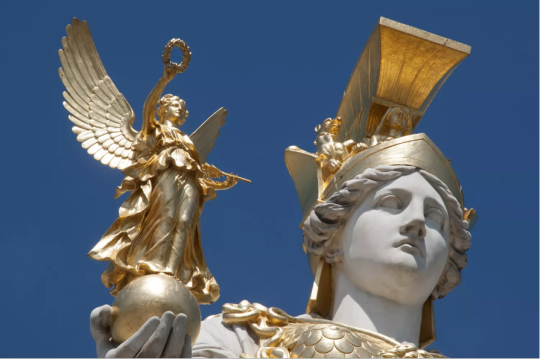
Detail from the Athena fountain, Parliament Building of Vienna, showing Nike the Winged Victory in the palm of Athena's hand [source]
Nike is a minor Greek deity, said to be the daughter of Pallas (a Titan) and the river Styx. Her other siblings by the same parents include Zelus (Zeal), Bia (Might) and Kratos (Strength).
Yes. That Kratos.
She was one of the earliest gods to pledge her allegiance to Zeus in the Titonomachy, and after the victory of the Olympians, Nike and the other gods that allied with them were allowed to live on Olympus. In her aspect as Victory, she is closely associated with several of the major Greek gods, and in particular, Athena.
There's also her Roman counterpart, Victoria. This version doesn't come with the backstory Nike has, but is more of a general concept of victory. This is the aspect that is present in a lot of the modern sculptures and interpretations of Nike/Victoria:
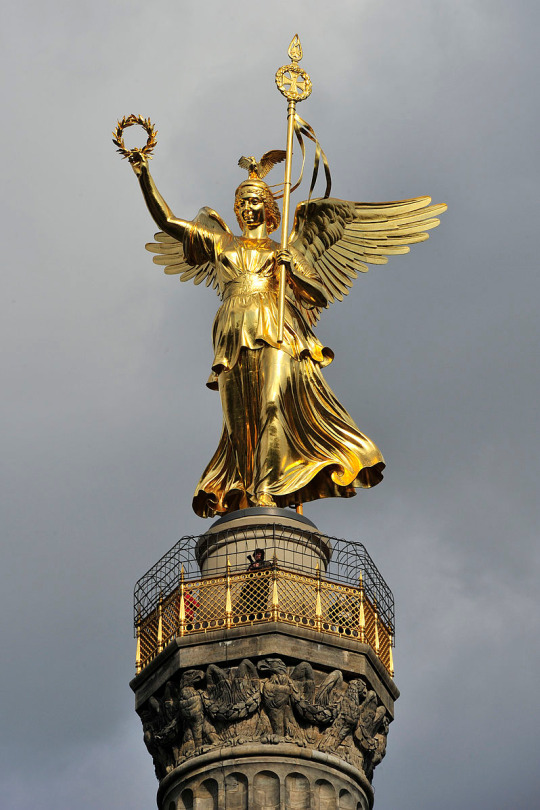
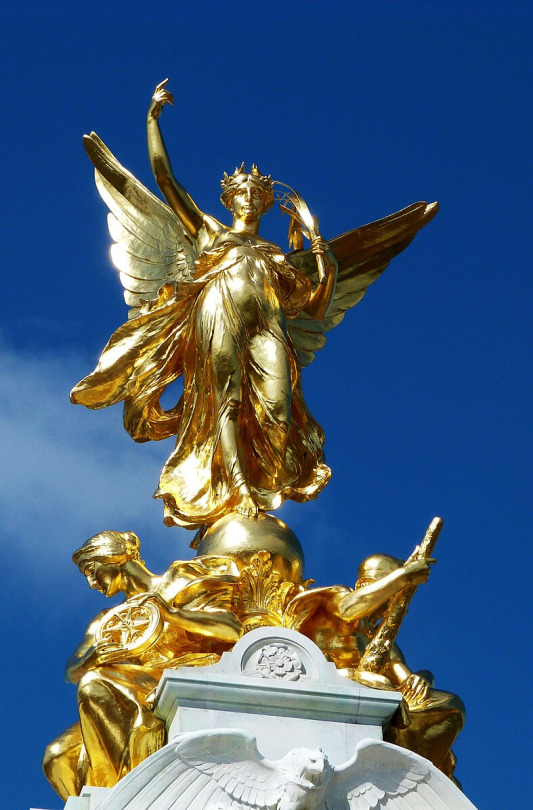
Left: Detail from the Berlin Victory Column. Right: Detail from the Victoria Memorial, London. Note the similar iconography, of a woman seemingly standing against a strong wind, fabric and cloth adhering and yet flowing against the breeze, wings outstretched.
From this, we can probably extrapolate what our beloved Winged Victory might've looked like. Here's an artist's render of one possibility:

There's some iconography we need to go through before moving on - symbols that are commonly associated with Nike/Victoria.
One is the trumpet as see in the reconstruction above, the sound and symbol of the end of war, of impending peace. Another is the laurel wreath, another Greek symbol of victory and achievement. Famously, laurel wreaths were used to crown victors of the original Olympic games.
This is another conversation entirely, but there’s a discussion to be had about the duality of Elgar’nan and Mythal, in term of vengeance and justice, and how an emotional rage versus a calculated wisdom can be compared to the difference between the two Greek gods of war – Ares and Athena.
If we can compare Mythal to Athena, in the sense of her wisdom in making difficult decisions, then it’s not a stretch to associate Mythal with the symbolism of Nike, and therefore explain the presence of statues similar to the Winged Victory in her temple.
But since Bioware absolutely did not put this in the game for anything other than the Aesthetic, there’s some problems that need to be addressed.
Mainly in the way in which these statues are scattered throughout the temple. If you wanted static, ominous statues to line the walls as your player characters explore, perhaps have like, I dunno. Less dynamic statues that you reference?
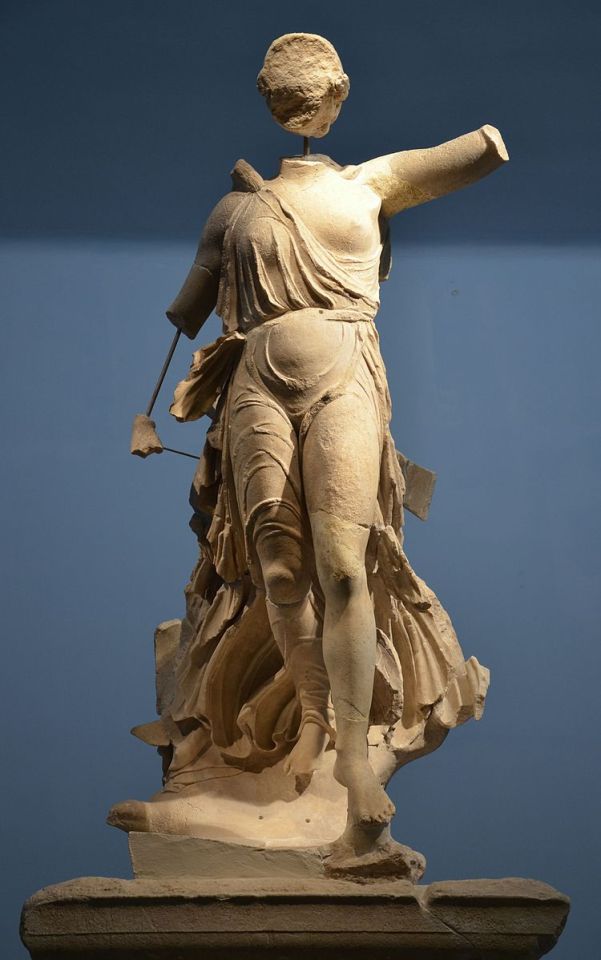
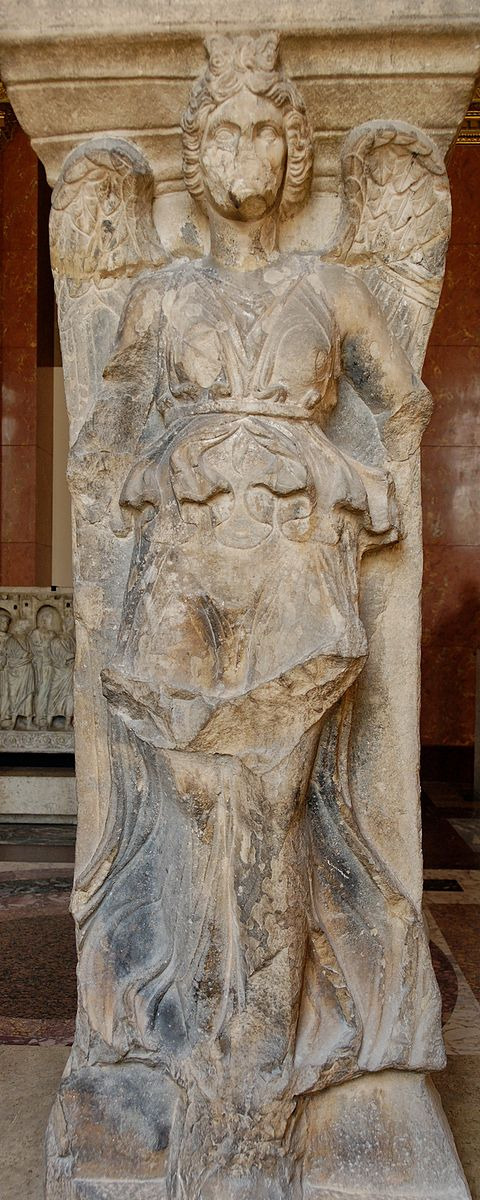
Left: Nike of Paionos, Right: Stele 1 of Las Incantadas
Or maybe instead of statues, have friezes lining the walls. Like this one from the equally iconic Pergamon altar, depicting the Giganomanchy.
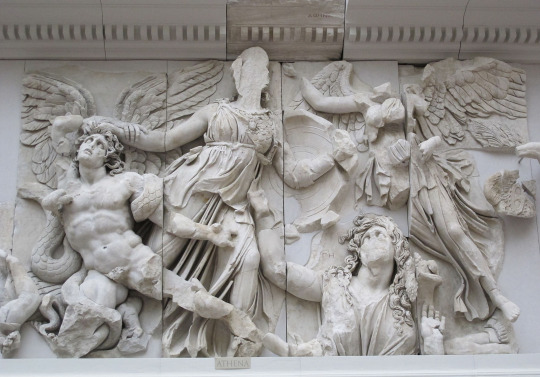
It’s the same symbolism, the wings, the smiting of foes and victory of good over evil.
And then perhaps, at the heart of the temple... where, y'know Bioware, lay a body of water sacred to Mythal herself, you could've perhaps done something remarkable. You could then have had the most dramatic and beautiful entrance you’d ever seen.
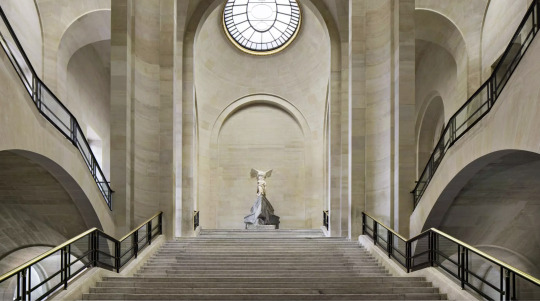
[Nike, at the iconic Daru Staircase, the Louvre]
It was at this moment that Mythal walked out of the sea of the earth's tears and onto the land. She placed her hand on Elgar'nan's brow, and at her touch he grew calm and knew that his anger had led him astray. - Codex entry: Mythal: The Great Protector
Mythal herself strides out of the Well Of Sorrows, the metaphorical tears of her followers that died and kept their knowledge alive in her name. Her (draconic) wings spread out, (restored) hands outstretched to touch her husband, to calm the rage that nearly destroyed this world.
A symbol of victory against the blind rage of a god against His father, the Sun. A symbol of wisdom and grace, against the violence of hatred. A divine sense of something bigger than anything we could imagine.
There's also the lack of iconography regarding victory, instead piling on some cheap representations of what we think of as Mythal. That's another post entirely on the symbolism of the Elven gods, but if Bioware really wanted to hone in on the Athena/Athena Nike parallels, they might have thrown in the trumpet/laurel/palm leaf symbolism with the statues, alongside the dragon wings.
If this were the case, then maybe, just maybe, Inquisition would’ve then earned the use of this sculpture in the game.
Sources not listed above/Further reading if you're interested
https://www.louvre.fr/en/explore/the-palace/a-stairway-to-victory
https://www.worldhistory.org/article/1412/winged-victory-the-nike-of-samothrace/https://smarthistory.org/nike-winged-victory-of-samothrace/
https://smarthistory.org/nike-winged-victory-of-samothrace/
https://www.khanacademy.org/humanities/ancient-art-civilizations/greek-art/hellenistic/a/nike-winged-victory-of-samothrace
#da lore#da meta#mythal#temple of mythal#dragon age#da lore and meta#yo this has been simmering and brewing in my brain for like 8 years now not kidding#and im already neck deep in like..... figuring out the evanuris and trying to tie them into real world mythology and thats super fun too!!!#watch as this consumes and destroys me#my writing
161 notes
·
View notes